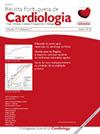在高血压人群中使用 SCORE2 进行心血管风险评估--基层医疗机构的实际情况。
IF 1.6
4区 医学
Q3 CARDIAC & CARDIOVASCULAR SYSTEMS
引用次数: 0
摘要
导言和目标:心血管疾病(CVD)是葡萄牙人发病和死亡的主要原因,因此识别高危人群非常重要。高血压患者发生不良心血管(CV)事件的风险增加。低密度脂蛋白胆固醇(LDL-C)在动脉粥样硬化性心血管疾病中的作用已得到证实。SCORE2 是一种新的心血管疾病风险计算工具,用于预测 10 年致命或非致命心血管疾病的风险。本研究旨在了解 SCORE2 与之前使用的 SCORE 相比,对中等风险国家高血压人群心血管风险评估的影响:这项观察性横断面研究对 3146 名确诊为高血压且无并发症的患者(K86)进行了人口普查分析。在应用纳入和排除标准后,654 名患者被纳入研究。研究人员收集了病历数据,以计算和比较 SCORE 和 SCORE2 类别以及低密度脂蛋白胆固醇目标值:结果:患者被分为 SCORE 类别:结果:患者被分为 SCORE 类别:188 人(28.75%)低风险、448 人(68.5%)中度风险、17 人(2.6%)高风险和 1 人(0.15%)极高风险。利用 SCORE2,SCORE 低风险类别中的个人被重新分类,需要新的目标:149 人(80%)被归为中低风险,39 人(20%)被归为高风险。在考虑 SCORE 中度和高度风险类别时,这些差异变得更加明显,有 358 名患者(77%)被划分为较高的 CV 风险类别,因此低密度脂蛋白胆固醇目标值较低。与 SCORE 相比,使用 SCORE2 时未能达到目标的患者人数明显增加(p 结论:这些研究结果支持使用 SCORE2 算法对高血压患者进行心血管风险评估的重要性。本文章由计算机程序翻译,如有差异,请以英文原文为准。
Cardiovascular risk assessment using SCORE2 in a population with hypertension – The reality at a primary health care unit
Introduction and objectives
Cardiovascular disease (CVD) is the leading cause of morbidity and mortality in Portugal, thus it is important to identify individuals at risk. Patients with hypertension have an increased risk of adverse cardiovascular (CV) events. The role of LDL cholesterol (LDL-C) in atherosclerotic CVD is well-established. SCORE2, a new CV risk calculation tool, is used to predict the 10-year risk of fatal or non-fatal CVD. The aim of this study was to understand the impact of SCORE2 on CV risk assessment in a population with hypertension from a moderate risk country, compared to the previously used SCORE.
Methods
This observational cross-sectional study analyzed a population census of 3146 patients diagnosed with hypertension without complications (K86). After applying inclusion and exclusion criteria, 654 patients were included. Data from medical records were collected to calculate and compare SCORE and SCORE2 categories and LDL-C targets.
Results
Patients were classified into SCORE categories: 188 (28.75%) low, 448 (68.5%) moderate, 17 (2.6%) high and 1 (0.15%) very high risk. Using SCORE2, individuals in the SCORE low risk category were reclassified, requiring new targets: 149 individuals (80%) as low to moderate and 39 (20%) as high risk. These differences became more evident when considering SCORE moderate and high-risk categories, where 358 patients (77%) received a higher CV risk categorization, and therefore a lower LDL-C target. There was a significant increase in individuals failing to meet the target when using SCORE2, compared to SCORE (p<0.001).
Conclusion
These findings support the importance of CV risk assessment using SCORE2 algorithm in patients with hypertension.
求助全文
通过发布文献求助,成功后即可免费获取论文全文。
去求助
来源期刊

Revista Portuguesa De Cardiologia
CARDIAC & CARDIOVASCULAR SYSTEMS-
CiteScore
2.70
自引率
22.20%
发文量
205
审稿时长
54 days
期刊介绍:
The Portuguese Journal of Cardiology, the official journal of the Portuguese Society of Cardiology, was founded in 1982 with the aim of keeping Portuguese cardiologists informed through the publication of scientific articles on areas such as arrhythmology and electrophysiology, cardiovascular surgery, intensive care, coronary artery disease, cardiovascular imaging, hypertension, heart failure and cardiovascular prevention. The Journal is a monthly publication with high standards of quality in terms of scientific content and production. Since 1999 it has been published in English as well as Portuguese, which has widened its readership abroad. It is distributed to all members of the Portuguese Societies of Cardiology, Internal Medicine, Pneumology and Cardiothoracic Surgery, as well as to leading non-Portuguese cardiologists and to virtually all cardiology societies worldwide. It has been referred in Medline since 1987.
 求助内容:
求助内容: 应助结果提醒方式:
应助结果提醒方式:


